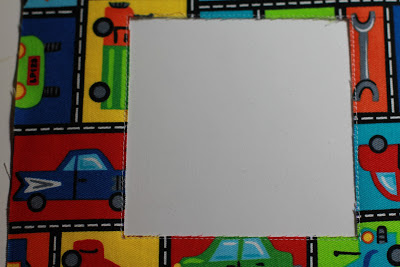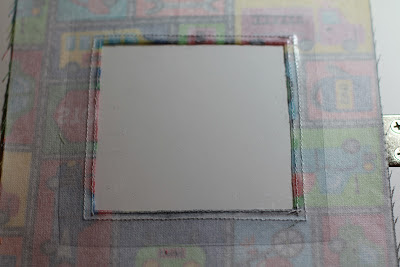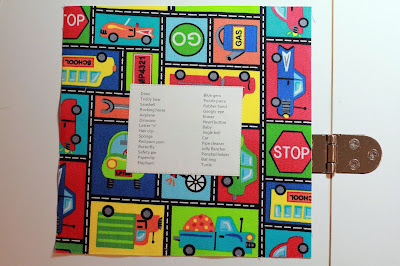Materials Needed:
¼ yard woven material (I used twill)
Fusible interfacing
6 x 6-inch piece of heavy vinyl (bought at WalMart or Jo-Anns)
9-10 oz. Poly Pellets® weighted stuffing material (bought at Jo-Anns)
Miniature items to place in bag (around 28 or so)
Iron-On Quick Fuse™ fabric sheets (bought at Jo-Anns)
Thread
FrayCheck™ (available at WalMart, Jo-Anns or fabric store)
Invisible marking pen
Pins
1. Cut two pieces of 8 x 8-inch square fabric.
2. Cut two pieces of 8 x 8-inch square fusible interfacing and fuse to wrong side of each fabric piece. Since I decided to use twill, this made it more stable and less likely to fray. You can skip this step if your fabric seems sturdy enough to stand on its own.
3. On the right side of one piece of fabric mark a line with a disappearing marking pen 2 inches from each side, forming a 4 x 4-inch square. With a rotary cutter cut along the lines, being careful not to cut too close to the corners. Finish cutting the corners with a sharp scissors. You can cut a smaller square if you want to make it harder to "spy" inside the bag or you can cut out a different shape such as a circle, heart, star, diamond, etc.
4. Center the vinyl under the fabric with the 4 x 4-inch cutout placed right side up and secure in place with pins or Scotch® tape. I preferred Scotch® tape placed underneath the fabric at two of the four corners of the vinyl so that the fabric would lie flat. Do not place tape on any of the vinyl that will show in the window as the residue will be difficult to remove.
5. Stitch close to the edges around all four sides of the window opening and secure stitching with backstitch at the end. Stitch again about ¼ inch away forming a double row of stitching. Treat innermost edge of fabric with FrayCheck™to stop the fabric from fraying and wipe the residue from vinyl with tissue before it dries. Trim away excess vinyl. If you prefer, you can stitch around the opening with a small zig-zag or appliqué type stitch that will finish the edge and skip the FrayCheck™.
¼ yard woven material (I used twill)
Fusible interfacing
6 x 6-inch piece of heavy vinyl (bought at WalMart or Jo-Anns)
9-10 oz. Poly Pellets® weighted stuffing material (bought at Jo-Anns)
Miniature items to place in bag (around 28 or so)
Iron-On Quick Fuse™ fabric sheets (bought at Jo-Anns)
Thread
FrayCheck™ (available at WalMart, Jo-Anns or fabric store)
Invisible marking pen
Pins
1. Cut two pieces of 8 x 8-inch square fabric.
3. On the right side of one piece of fabric mark a line with a disappearing marking pen 2 inches from each side, forming a 4 x 4-inch square. With a rotary cutter cut along the lines, being careful not to cut too close to the corners. Finish cutting the corners with a sharp scissors. You can cut a smaller square if you want to make it harder to "spy" inside the bag or you can cut out a different shape such as a circle, heart, star, diamond, etc.
4. Center the vinyl under the fabric with the 4 x 4-inch cutout placed right side up and secure in place with pins or Scotch® tape. I preferred Scotch® tape placed underneath the fabric at two of the four corners of the vinyl so that the fabric would lie flat. Do not place tape on any of the vinyl that will show in the window as the residue will be difficult to remove.
6. Type a list of items to be included inside the bag and follow directions to prepare a Quick Fuse™ fabric sheet. I had 28 items, but you can have more or less. Just remember that the larger the items are and the more you have of them, the less pellets you will be able to fit into your bag and the easier it will be to "spy" and find them.
An 8½ x 11-inch Quick Fuse™fabric sheet will make several lists if you want to make more than one bag. After printing on the fabric sheet, allow it to dry 1-2 minutes. Trim around image, leaving a border for stitching the list to the back piece of fabric. Preheat iron to medium/high (cotton) setting. NO STEAM. Place image face UP on right side of back piece and press 10-15 seconds making sure all areas of the sheet are thoroughly fused.
7. Stitch around edge of the list with decorative or straight stitch to secure.
8. Pin front and back pieces of bag with right sides together and stitch ½-inch seams around three sides, leaving the fourth side open for turning.
9. Clip corners and turn inside out.
10. Fill with miniature items, checking with the list for accuracy. Fill the bag ⅔ full with Poly Pellets®. I used about 2 level cups which weighed about 9-9½ oz. The more pellets you use, the harder the items will be to find.
11. Fold down ½-inch seam allowance on open end and stitch close to the edge, being very careful not to sew over the pellets so you don't break a needle. Sew around the edges of the other three sides to secure the seams and help the bag lie flat.
Voila! You're done.


















